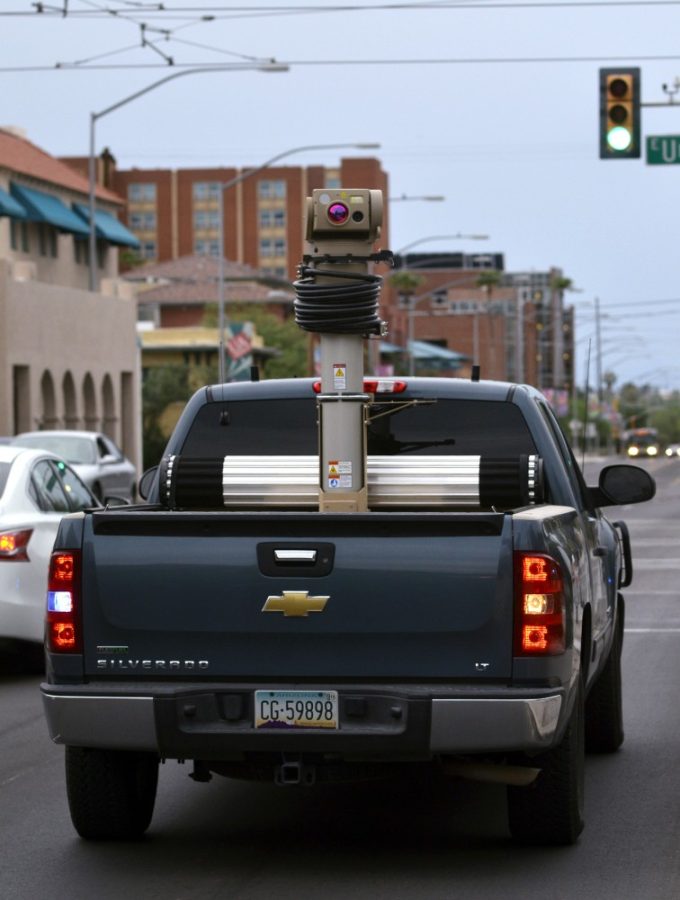Far from the exclusive realm of federal organizations like the National Security Agency, intrusive surveillance methods and technology have become standard tools for government groups as small as local police departments and as large as the Internal Revenue Service.
The Department of Homeland Security’s Operation Stonegarden is intended to improve border security. It has allowed the purchase of surveillance equipment by local law enforcement agencies, such as the Tucson Police Department, with little control on its use outside of the program.
New technologies
Advancements in digital surveillance exploit the expanding role of technology in everyday life. One frequently-cited example is Stingray Surveillance Technology, a type of cell phone tower simulator developed by the Florida-based Harris Corporation. [1]
“Stingray devices … [tricked] phones in that area into connecting to that device instead of the closest tower,” said Will Gaona, policy director of the American Civil Liberties Union of Arizona. “And that [gave] law enforcement access to—at a minimum—the location of those phones and provides real-time tracking.”
Gaona added that the devices could also allow police to see the content of text messages and other data sent by phones in the area, depending on their use.
While this may have be useful for tracking a suspect, the technology wasn’t targeted and gave law enforcement the ability to indiscriminately see the information of all cell phones in the area, according to Gaona.
Agencies as disconnected from law enforcement as the IRS have used Stingrays, according to Derek Bambauer, an associate professor at the James E. Rogers College of Law, who has studied internet censorship and surveillance.
The devices were widespread, according to Gaona. Arizona users included the Tucson, Tempe and Phoenix police departments and the Maricopa County Sheriff’s Office.
‘Secrecy to the highest degree’
The prevalence of such equipment impacts the ability of citizens to take part in government, according to Gaona.
“The ability to protest, to demonstrate—that’s an important part of participating in our society and in government,” Gaona said. “And when the government tracks and surveils and keeps a list of people that participate in those types of things, it certainly discourages people from that type of participation.”
Federal grant programs, like Operation Stonegarden, finance some surveillance equipment used by police departments in keeping tabs on political demonstrations, including a vehicle-mounted camera system, developed by Tucson-based Strongwatch Corporation, known as Freedom On-The-Move. Maintained by the Department of Homeland Security, the grant program is intended to defray the costs of border security by local law enforcement agencies in states sharing an international or sea border, according to the DHS website.
The Freedom On-The-Move system combines an infrared and a conventional camera with a zoom lens in a stabilized housing atop a mast mounted to a vehicle.
The Pima County Sheriff’s Department paid more than $200,000 for its border crime unit’s camera system after receiving about $124,000 in funding through Operation Stonegarden, according to documents obtained by the Daily Wildcat.
While not the specific device purchased by Pima County Sheriff’s Department, the camera has been used in at least one instance to monitor an anti-Islamophobia demonstration in Tucson. [2]
“That’s one way in which government surveillance impacts peoples’ ability to participate in society and in our government,” Gaona said.
The Arizona branch of the ACLU is involved in a lawsuit against the City of Tucson, seeking the release of documents related to TPD’s use of stingrays, according to Gaona.
Pete Kraska, chair of graduate studies and research in the School of Justice Studies at Eastern Kentucky University, suggests this lack of transparency is systemic in law enforcement.
“I think that the current model of policing … is all about creating a system that values secrecy to the highest degree,” Kraska said.
Beyond the content
While many point to the Fourth Amendment as a safeguard against mass digital surveillance, the actual data attached to a communication—known as metadata—is afforded fewer protections than the content itself, according to Bambauer.
“What we think of as the way to get information around—telephone numbers, IP addresses, email addresses, URLs, typically called routing information—tends to receive less [legal protection],” Bambauer said.

Compiling a clear picture of the user is fairly simple with enough metadata. This concept is known as mosaic theory.
“If you get all the email addresses of people who are emailing me, if you are able to track my cell phone as it goes by cell phone towers, you can build a pretty complete record of who I’m talking to, who I’m calling, where I’m going,” Bambauer said.
A confusing regulatory structure aids agencies in making their own rules for the collection of digital data.
Executive Order 12333 prohibits federal agencies other than the NSA from conducting electronic surveillance that includes content, but doesn’t cover metadata collection and isn’t binding for non-federal agencies, according to Bambauer. The only legal hurdle to clear for government organizations in pursuit of metadata is a subpoena under the Pen Register Act.
“[There is] virtually no barrier to getting it,” Bambauer said.
Pushing back
Some tools to make electronic communication more secure are growing in popularity along with bipartisan pushback against those advocating for pervasive surveillance.
Sarah Erickson, student activist and a junior studying linguistics and Russian, said she uses a proxy server when browsing the internet to make her activities more difficult to track.
A popular method of anonymous internet browsing, known as Tor, provides a layer of security for users beyond that of a single proxy but at the cost of a slower connection. The service routes internet traffic through three random, connected computers called nodes, but it is still vulnerable to certain types of cyber attacks.
Bambauer provided context for the growing public discontent toward the possible abuse of collected metadata by law enforcement and other government organizations. He noted similarities to historical government monitoring of activists like Martin Luther King Jr.
“I think that as we can store more information, as we can index it, as we can search it and as we increasingly start to use artificial intelligence to do some predictive work based on it …,” Bambauer said. “… I think that the aggregation of data, effectively with no check, is really worrisome from a privacy perspective.”
[1] This article has been updated to clarify that Stingray Surveillance Technology is no longer in use by TPD, who formally took the devices out of service in 2014.
[2] Pima County Sheriff’s Department does not own the truck and its camera equipment featured in the pictures above.
Follow Alex McIntyre on Twitter.









